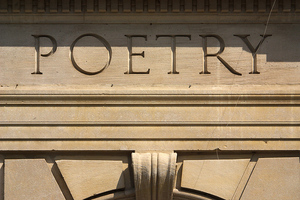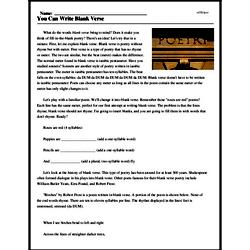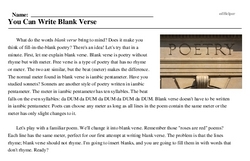You Can Write Blank Verse
What do the words blank verse bring to mind? Does it make you think of fill-in-the-blank poetry? There's an idea! Let's try that in a minute. First, let me explain blank verse. Blank verse is poetry without rhyme but with meter. Free verse is a type of poetry that has no rhyme or meter. The two are similar, but the beat (meter) makes the difference. The normal meter found in blank verse is iambic pentameter. Have you studied sonnets? Sonnets are another style of poetry written in iambic pentameter. The meter in iambic pentameter has ten syllables. The beat falls on the even syllables: da DUM da DUM da DUM da DUM da DUM. Blank verse doesn't have to be written in iambic pentameter. Poets can choose any meter as long as all lines in the poem contain the same meter or the meter has only slight changes to it.
Let's play with a familiar poem. We'll change it into blank verse. Remember those "roses are red" poems? Each line has the same meter, perfect for our first attempt at writing blank verse. The problem is that the lines rhyme; blank verse should not rhyme. I'm going to insert blanks, and you are going to fill them in with words that don't rhyme. Ready?
Roses are red (4 syllables)
Puppies are ___________________ (add a one-syllable word)
Pencils are ___________________ (add a one-syllable word)
And ________________ (add a plural, two-syllable word) fly
Let's look at the history of blank verse. This type of poetry has been around for at least 500 years. Shakespeare often formed dialogue in his plays into blank verse. Other poets famous for their blank verse poetry include William Butler Yeats, Ezra Pound, and Robert Frost.
"Birches" by Robert Frost is a poem written in blank verse. A portion of the poem is shown below. None of the end words rhyme. There are ten to eleven syllables per line. The rhythm displayed in the lines' feet is unstressed, stressed (da DUM).
When I see birches bend to left and right




